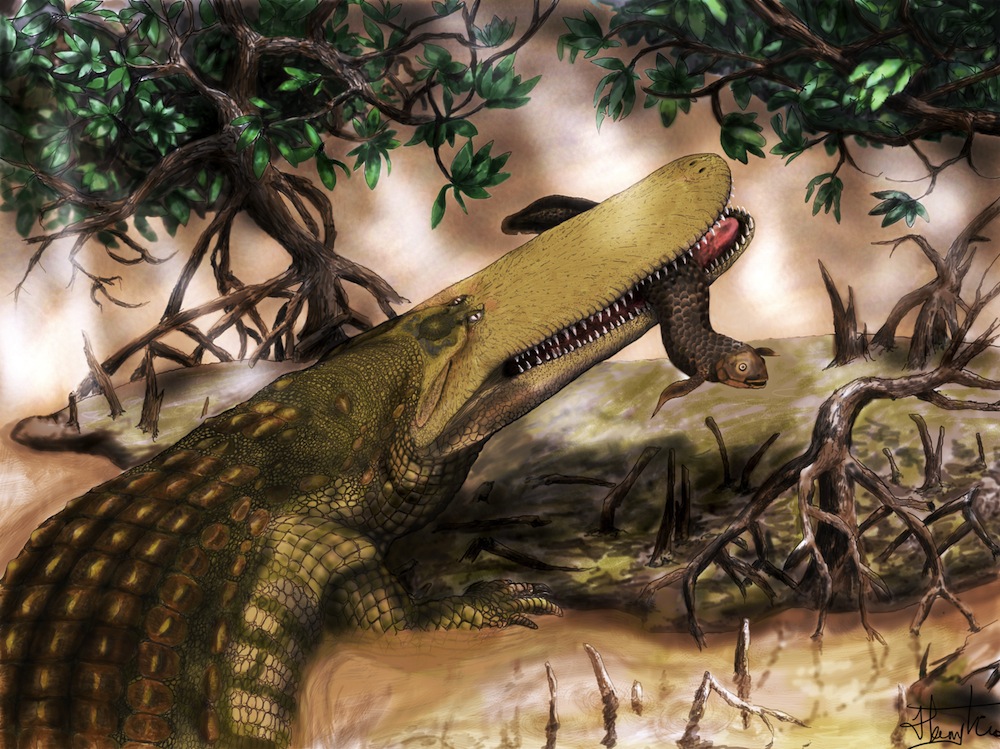Ancient Crocodile Wore Shield on Its Head

A giant prehistoric crocodile once bore a shield on its head, an ornament never before seen on these reptiles that may have been used to intimidate enemies and attract mates, researchers say.
"'Shieldcroc' is the earliest ancestor of our modern crocodiles to be found in Africa," said researcher Casey Holliday, a vertebrate paleontologist and evolutionary biologist at the University of Missouri at Columbia. "Along with other discoveries, we are finding that crocodile ancestors are far more diverse than scientists previously realized."
Shieldcroc was identified from a fossil piece of skull found in the deserts of southeastern Morocco. The fossil was held in the Royal Ontario Museum for several years until Holliday came across it in a drawer. The extinct creature lived about 95 million years ago back in what is popularly known as the Age of Dinosaurs, when the area was largely populated with freshwater lagoons with lush forests.
The reptile's scientific name is Aegisuchus witmeri — Aegis being Greek for shield, suchusbeing Greek for crocodile, and witmeri in honor of anatomist and paleontologist Lawrence Witmer. The researchers think the reptile belongs to a sibling group of the ancestors of modern crocodilians.
By analyzing dents and bumps that blood vessels left on the bones, researchers determined that the crocodilian would have possessed a circular structure on top of its head resembling a shield, a thing never seen before in a crocodilian. This shield may have been used to help control the temperature in the animal's head by circulating blood on a wide surface near the air, or for displays to potential friends and foes.
"Today's alligators and crocodiles use their heads to show off to mates or intruders onto their territory in a couple of different ways," Holliday told LiveScience. "Alligators often put their heads in the air to show off the profiles of their skulls. Crocodiles, on the other hand, put their heads toward intruders or mates in a way that shows off little horns on the backs of their skulls. We don't know what Shieldcroc might have done, but there's precedent for head displays with their living relatives." [Top 10 Deadliest Animals]
Shieldcroc had a flatter skull than other known species of crocodilians. This flatness may have made Shieldcroc's head too flimsy to wrestle dinosaurs. Instead, the researchers suggest that with its thin jaws, the ancient reptile likely caught fish.
Sign up for the Live Science daily newsletter now
Get the world’s most fascinating discoveries delivered straight to your inbox.
"We believe Shieldcroc may have used its long face as a fish trap," said researcher Nick Gardner at Marshall University. "It is possible that it lay in wait until an unsuspecting fish swam in front of it. Then, if it was close enough, Shieldcroc simply opened its mouth and ate the fish without a struggle, eliminating the need for strong jaws."
The bones suggest that Shieldcroc's head was not only flat, but long as well, at five feet (1.5 meters) in length. The reptile was 30 feet (9 meters) long overall.
"Scientists often estimate body size of crocodilians based on the size of the skull," Gardner said. "However, estimating the body size of Shieldcroc was difficult, due to the enormous size of the skull compared to other crocodilians. To make a size estimate, we compared several features of the bone to many different species."
These findings help show just how diverse crocodilians once were.
"Oftentimes, crocodilians are referred to as living fossils that haven't changed much in millions of years, but more and more, we're finding they were an incredibly diverse group of animals that filled every niche possible aside from flight," Holliday said.
The scientists detailed their findings online Jan. 31 in the journal PLoS ONE.
Follow LiveScience for the latest in science news and discoveries on Twitter @livescience and on Facebook.










